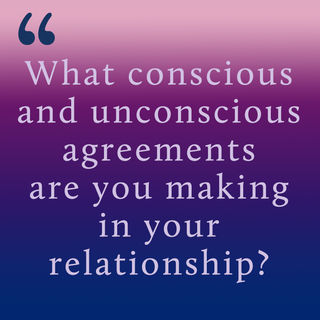Relationships
When Relationships Fall Apart
Conscious and unconscious agreements in a relationship.
Posted September 5, 2017 Reviewed by Jessica Schrader
Co-authored by Lisa Blair, M.A., and David Bedrick, J.D.
Every relationship has two handshakes: one above the table and one below. The first handshake is a conscious agreement between the two people, saying “We’re going to support each other, care for each other’s needs, listen to and accommodate each other, and compromise when we need to.” These are important agreements, however they are limited. As time passes, it typically becomes harder and harder to keep these agreements because previously unrevealed aspects of each person will arise that will not be in alignment with this initial contract.

The second handshake is an unspoken, unconscious agreement between the two people that says, “We’re each going to put away those aspects of ourselves that would threaten the relationship in order to make our life work well together, to avoid conflict, and to make each other comfortable, so that we may reach towards an ideal vision of the relationship.” This second agreement requires each person to suppress things about themselves—their personality, individual and cultural style, needs, and desires in order to not rock the boat. These aspects remain in the shadow of the relationship.
Suppressed aspects of each person may include: not wanting to be present or listen to your partner even though you think you ought to; taking alone time when you think you should always be together; following your own impulses (to travel, hang out with certain friends or family, watch your favorite TV shows, go skiing … the list is endless) even though your partner does not have the same level of interest in these activities.
Additionally, these things may include ways of expressing oneself or communicating in styles that are outside the comfort zone of the relationship or of the other partner. For example, one partner may naturally be more forceful, direct, or quick, in their communication style while the other partner is more sensitive, slow, shy, or quiet. The first partner may accommodate by suppressing their power and approaching the other with more gentleness. The second partner may suppress their softer nature and try to meet the other with more force. Neither is inherently bad to do, but these accommodations are not typically sustainable for long periods of time.
The Second Handshake Falters
At some point, the second handshake—which is not fully conscious—falters and the suppressed needs, desires, or ways of expressing oneself rise to the surface causing all sorts of problems. They come out in resentments, anger, dreams, illness, moods, affairs, and other disturbing experiences. At this point, important questions appear: How will I deal with these problems? Will I get depressed and take antidepressants in order to find a comfort zone? Will I ignore these impulses and revert back to the first handshake and say, “OK, I found a way to settle in this relationship and I can do this for the rest of my life.” Do I have the desire, willingness, and courage to embark on a warrior journey of personal and relationship growth with my partner?
Common Roads Couples Take

There are four common roads that couples take when faced with the challenge of addressing the unconscious needs, desires, and expressions that inevitably rise to the surface in all long-term relationships.
Road #1: We’ve found in our work with clients that if one or both partners aren’t open to working out a way for the newly surfaced needs, desires, or expressions to live, then the relationship will revert back to the status quo of the first handshake and develop coping strategies to deal with the disturbing aspects of the relationship. These strategies will inevitably be unsustainable and lead to more problems and pain. These individuals might in essence say, “I’m going to shop, gamble, take drugs, get depressed, or have an affair.” Or, “I’m going to put all of my focus, time, and energy into making more money and being more successful to avoid going home and relating to my partner.” Or as a couple, they might in essence say, “We’re going to go on more vacations so that we can pretend life feels good and our needs are getting met.” Reverting to the status quo of the first handshake is the most common road taken when suppressed experience surfaces in a relationship.
Road #2: A second road that a couple may find itself on is that of their children having difficulties that require professional help to address. In effect, the children begin living out the disturbing behaviors that the couple is not making room for. The couple may send their child to therapy because they have problems, becoming the “identified patient”—the one who appears ill when it is actually the family system that needs healing. Why wouldn’t you want to send your kids to therapy? What’s wrong with doing that? Seems to make perfect sense. However, the couple’s avoidance of their problems is causing the child to act out and this will continue unless and until the child is no longer seen as the identified patient and the couple begins to take responsibility for their relationship difficulties. Of course, this may not be the case in every situation where a child is acting out, but it’s always something to consider.
Road #3: The third road that many couples take is one with a dead end. In this scenario, the couple’s relationship terminates because it can’t accommodate the changes. That’s as far as it could go. It reaches a limit. The newly risen suppressed material is more than one or both partners can hold. It is too threatening or causes too much pain. The container is not strong enough and the relationship comes to an end.
Road #4: The fourth possible road that a couple can take requires significant changing and growing. The arms of the relationship get wider allowing it to move forward with the formerly suppressed experiences now integrated into the relationship. This is the least common of all possibilities because it requires that both partners want to learn and grow individually and in the relationship. It means each partner has to be willing to self-reflect, recognize their good intentions as well as their unconscious priorities, communicate honestly and openly with their partner, work through often painful conflict, and live closer to their individuated and more authentic self. This is not an easy path and typically requires the outside help of a therapist to facilitate the relationship transformation.
This path also requires that both people in the relationship are genuinely open to whatever specific change is presenting itself. If it is truly not right for one of the people in the relationship to be open to the change on the table, then to stay true to themselves and their deepest nature, they must remain closed to that change and the relationship may indeed end. There is no judgment, no blame here. Both people are open to learning and growing, but their nature says “no” to that specific change and so, ultimately the person has to choose to be true to themselves over keeping the relationship intact.
When One Partner Is a Grower and the Other Is Not

In long-term relationships, such as marriage, there is sometimes one partner who is more of a grower (a person who loves learning, growing, and changing over time) and one who is not. In our experience, in a heterosexual relationship, the grower is more often a woman than a man, but of course, this is not universally true. Women are more likely than men to go to therapy and pursue personal growth in general. Sometimes, we have found, a woman partner will call to make an appointment for couples therapy with her male partner. When we ask her, “Does your partner want to come to therapy?” she says, “Well, I’m going to check with him, but I think he’d be willing to.” In situations like this, it’s invariably the case that the woman alone wants to go to therapy and the man is really not interested in doing therapeutic work. She wants to look at the relationship and interact about it, figure out who she is, learn new things, and become a new kind of person. But her male partner may be saying, “This is hard work and it costs a lot of money and it’s taking away from my life.” For her, the therapy is life-giving; for him, it’s not.
In this case, couples therapy is contraindicated; the woman would benefit more from individual therapy. It will not be wise for her to embark on a path of trying to change him. Either she’s going to find a way to create meaningful “separations” from her partner without actually terminating the relationship (e.g., following a career that she never pursued, hanging out with friends that she never made time for, not caring so much if her partner is in a bad mood, or separating herself emotionally and potentially financially) or she may eventually need to leave all the way.
The Tao in Relationship
While there is certainly much to be said for our personal efforts to grow and develop in a relationship and the fact that these efforts have a significant effect on the resiliency of our relationship, the truth is—what happens in our relationship is not only up to us. What happens in our relationships, including how long they last, is also subject to the Tao, nature, the universe, God—whatever name you wish to give it, it has its own timing. Relationships have their own course and we cannot only control the outcome.
In a public lecture, author, activist, and seven-time NAACP Image Award recipient Nikki Giovanni explained the Tao in relationship in a most amusing, creative, and accurate way. She said (we’re paraphrasing), “Remember those fortune telling machines, like Zoltar at Coney Island? They spit out a ticket with your fortune.”
“With relationships,” she explained, “it’s as if the fortuneteller spits out a card telling the person how long their relationship is supposed to last. For example, the card might read one night, two months, twenty years, or a lifetime. Not all relationships are meant to last a lifetime. When the relationship goes longer than it’s supposed to—which is the most common occurrence—all sorts of problems occur and if the relationship does end at some point, each of the people typically feel terrible about how it ended, they hate the other person, and there’s a lot of pain. When the relationship gets cut short for some reason, the two people often forever imagine how perfect the other person was and how they could have been the love of their life. However, when the relationship ends exactly at the time predicted by the fortuneteller—the least common experience in relationships ending—it is typically bittersweet. Each person feels love and kindness towards the other, gratitude for what they shared together, and at peace with the knowledge that it had to end.”




